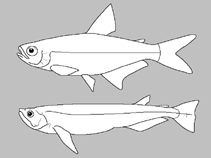Envoyez vos Photos et vidéos
Images GoogleNo image available for this species;
drawing shows typical species in Characidae.
Images GoogleNo image available for this species;
drawing shows typical species in Characidae.
Classification / Names Noms communs | Synonymes | Catalog of Fishes(Genre, Espèce) | ITIS | CoL | WoRMS | Cloffa
> Characiformes (Characins) > Characidae (Characins; tetras) > Stethaprioninae
Etymology: Astyanax: The name of Astyanax, Hector´s son in the Greek mythology (Ref. 45335); procerus: From the Greek adjective procerus, meaning tall, in reference the high body depth of the species.
Eponymy: Astyanax was the son of Hector in Greek mythology. See Homer’s Iliad for details. The reasoning for its use for a genus of characins is not explained. (Ref. 128868), visit book page.
Etymology: Astyanax: The name of Astyanax, Hector´s son in the Greek mythology (Ref. 45335); procerus: From the Greek adjective procerus, meaning tall, in reference the high body depth of the species.
Eponymy: Astyanax was the son of Hector in Greek mythology. See Homer’s Iliad for details. The reasoning for its use for a genus of characins is not explained. (Ref. 128868), visit book page.
Environment: milieu / climate zone / depth range / distribution range Écologie
; eau douce benthopélagique. Tropical
Distribution Pays | Zones FAO | Écosystèmes | Occurrences | Point map | Introductions | Faunafri
South America: upper and middle rio Taquari-Antas and rio Jacuí, laguna dos Patos
system in Rio Grande do Sul, Brazil.
Taille / Poids / Âge
Description synthétique Clés d'identification | Morphologie | Morphométrie
Rayons mous dorsaux (Total) : 10 - 11; Vertèbres: 36 - 38. This species is distinguished from all congeners in the rio Uruguay basin, laguna dos Patos and rio Tramandaí systems by having the following characters: two humeral spots (vs. one in Astyanax eigenmanniorum, A. sp. aff. fasciatus, A. jacuhiensis, and A. laticeps); first humeral spot vertically elongate with upper portion wider portion narrow and curved, with a pronounced constriction at the junction of both portions (vs. present of oval shape spot with two brown vertical bars in humeral region in A. jacuhiensis, oval shape in A. laticeps and forming a uniform wedge in A. eigenmanniorum and A. henseli); anal fin with 8-23 branched rays (vs. 18 or less in A. rachypterygium and A.cremnobates, 23 or more in A. aramburui, A. paris, A. saguazu, and A. stenohalinus); one maxillary tooth (vs. 2-5 in A. henseli); maxillary teeth tri- to pentacuspid (vs. hexa- to heptacuspid in A. dissensus and A. ojiara); and body depth 38.3-46.0% of SL (vs. smaller than 38% of SL in A. brachypterygium, A. cremnobates, A. obscurus, and A. xiru). It is most similar to A. xiru in color pattern, but it can be differentiated by the pelvic-fin length 16.1-18.7% of SL (vs. 13.6-17.1%), dorsal-fin length 24.1- 28.7% of SL (vs. 21.1-25.4%) and absence of bony hooks on the anal and pelvic fins of males (vs. presence) (Ref. 94153).
Life cycle and mating behavior Maturité | Reproduction | Frai | Œufs | Fécondité | Larves
Référence principale
Upload your references | Références | Coordinateur | Collaborateurs
De Lucena, C.A.S., J.B. Castro and V.A. Bertaco, 2013. Three new species of Astyanax from drainages of southern Brazil (Characiformes: Characidae). Neotrop. Ichthyol. 11(3):537-552. (Ref. 94153)
Statut dans la liste rouge de l'IUCN (Ref. 130435: Version 2024-2)
Préoccupation mineure (LC) ; Date assessed: 07 November 2018
CITES
Not Evaluated
Menace pour l'homme
Harmless
Utilisations par l'homme
FAO - Publication: search | FishSource |
Plus d'informations
Trophic ecology
Éléments du régime alimentaire
Composition du régime alimentaire
Consommation alimentaire
Food rations
Prédateurs
Éléments du régime alimentaire
Composition du régime alimentaire
Consommation alimentaire
Food rations
Prédateurs
Ecology
Écologie
Écologie
Population dynamics
Paramètres de croissance
Max. ages / sizes
Length-weight rel.
Length-length rel.
Fréquences de longueurs
Mass conversion
Recrutement
Abondance
Paramètres de croissance
Max. ages / sizes
Length-weight rel.
Length-length rel.
Fréquences de longueurs
Mass conversion
Recrutement
Abondance
Life cycle
Reproduction
Maturité
Maturity/Gills rel.
Fécondité
Frai
Spawning aggregations
Œufs
Développement de l'œuf
Larves
Dynamique des populations larvaires
Reproduction
Maturité
Maturity/Gills rel.
Fécondité
Frai
Spawning aggregations
Œufs
Développement de l'œuf
Larves
Dynamique des populations larvaires
Anatomy
Surface branchiale
Brain
Otolith
Surface branchiale
Brain
Otolith
Physiology
Body composition
Nutrients
Consommation d'oxygène
Type de nage
Vitesse de nage
Visual pigments
Fish sound
Diseases & Parasites
Toxicity (LC50s)
Body composition
Nutrients
Consommation d'oxygène
Type de nage
Vitesse de nage
Visual pigments
Fish sound
Diseases & Parasites
Toxicity (LC50s)
Genetics
Génétique
Heterozygosity
Héritabilité
Génétique
Heterozygosity
Héritabilité
Human related
Aquaculture systems
Profils d'aquaculture
Souches
Ciguatera cases
Stamps, coins, misc.
Aquaculture systems
Profils d'aquaculture
Souches
Ciguatera cases
Stamps, coins, misc.
Outils
E-book | Guide de terrain | Générateur de fréquences de longueur | Outil de dynamique de population | Carte par point | Classification Tree
| Catch-MSY |
Articles particuliers
Télécharger en XML
Sources Internet
AFORO (otoliths) | Aquatic Commons | BHL | Cloffa | BOLDSystems | Websites from users | FishWatcher | CISTI | Catalog of Fishes: Genre, Espèce | DiscoverLife | ECOTOX | FAO - Publication: search | Faunafri | Fishipedia | Fishtrace | GenBank: génôme, nucléotide | GloBI | Google Books | Google Scholar | Google | IGFA World Record | MitoFish | Otolith Atlas of Taiwan Fishes | PubMed | Reef Life Survey | Socotra Atlas | Arbre de Vie | Wikipedia: aller à, chercher | World Records Freshwater Fishing | Zoobank | Zoological Record
Estimates based on models
Phylogenetic diversity index (Ref. 82804): PD50 = 0.5000 [Uniqueness, from 0.5 = low to 2.0 = high].
Bayesian length-weight: a=0.01096 (0.00493 - 0.02437), b=3.10 (2.93 - 3.27), in cm total length, based on LWR estimates for this Genus-body shape (Ref. 93245).
Niveau trophique (Ref. 69278): 2.8 ±0.4 se; based on size and trophs of closest relatives
Résilience (Ref. 120179): Haut, temps minimum de doublement de population inférieur à 15 mois (Preliminary K or Fecundity.).
Fishing Vulnerability (Ref. 59153): Low vulnerability (10 of 100).




